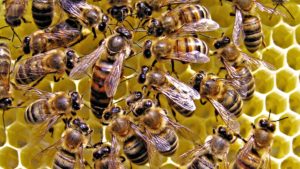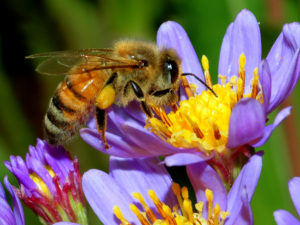By Dr. Beth Leermaker
Can you imagine a world without almonds? Without honey bees, there would be no almonds. Honey bees are essential for pollinating many flowers, fruits and vegetables. About a third of all the food Americans eat — including citrus fruit, berries, pears, apples, avocados, broccoli and cucumbers — depend on honey bee pollination. Almonds are particularly reliant on honey bees.

Photo courtesy of Melissa Zupan
Honey bees are well adapted to transfer pollen between flowers. Their hairy bodies, static electricity generated while flying and pollen baskets on their hind legs allow honey bees to hold many pollen grains. When the bees groom the pollen grains off their body hairs, some of them fall off and land on the flower’s waiting stigma, completing the pollination process and starting the flower’s fertilization process. These perfect pollinators can visit 50–100 flowers in a single trip. If each bee makes 10 trips per day, a colony with 25,000 bees can pollinate 250 million flowers per day!
Unfortunately, for the past 10 years, honey bees have been dying unexpectedly — 30 percent or more every year. In 2018, American beekeepers reported that 40 percent of their hives (aka colonies) died during the year, up from 33 percent in 2017. Fortunately, higher death rates haven’t resulted in a decline in the number of U.S. beehives, since beekeepers have been replenishing lost colonies with new ones.
However, pollination costs have risen with the added expense of frequent hive replacement. In California, pollination fees more than tripled from 2003 ($52 per hive) to 2016 ($180-$200 per hive).
California’s almond orchards require 1.6 million bee colonies, so the increased cost is substantial. As a result, we see higher prices at the grocery store.
Referred to as colony collapse disorder (CCD), billions of honey bees across the world are leaving their hives, never to return. CCD occurs when the majority of worker bees in a colony disappear, leaving behind a queen, plenty of food and a few nurse bees to care for the remaining immature bees and the queen.
There are several possible causes for CCD:
A parasitic mite (Varroa) is the largest single cause of honey bee decline, resulting in the loss of tens of thousands of honey bee colonies every year. The Varroa mite weakens honey bees, making them more susceptible to viruses, bacteria and fungi. Beekeepers usually control Varroa by using a mite-specific insecticide, but the Varroa mite is developing resistance to some of the chemicals in the insecticide.
Pesticides can kill or harm bees. Even pesticide chemicals that don’t kill bees outright can cause them to become disoriented, less efficient at what they do, and/or reduce their life span. Bees are sensitive to many pesticides approved for home use, including neonicotinoid and pyrethroid insecticides. Increased use of neonicotinoid insecticides (aka “neonics”) may be causing the decline of honey bees. Although there isn’t enough evidence to conclude that pesticide-contaminated pollen or nectar is causing the bee decline, these insecticides can be harmful to bees if not used properly.
Climate change. Changes in climate or weather affect food and forage for bees. Abnormal temperature patterns can disrupt bee feeding patterns and increase their vulnerability to diseases.
How You Can
Help Protect Bees
Limit bees’ exposure to pesticides, especially insecticides and fungicides. Avoid spraying pesticides whenever bees are present or when flowers are blooming. If you must use a pesticide, choose a product with low toxicity to bees (consult the product label). Apply pesticide late in the day, just before dark, or early in the morning when bees aren’t present.
Plant a variety of flowers, including some that will bloom in the early spring and others that will bloom until the fall.

Photo courtesy of Finger Lakes Land Trust
Bees are healthier when they have a variety of pollen and nectar sources. Choose flowering plants that don’t need to be sprayed with insecticide to control pests. Plants such as lavender, chives, borage, sage, oregano, sunflowers, phacelia, clover, mint and dandelion are all excellent sources of pollen and nectar, and they grow well without pesticides.
I have a black thumb, so I won’t be planting flowers, but I have stopped digging up the dandelions in my yard. If my neighbors complain, I’ll tell them I’m leaving them for the bees. What can you do to help protect honey bees and our produce supply?
